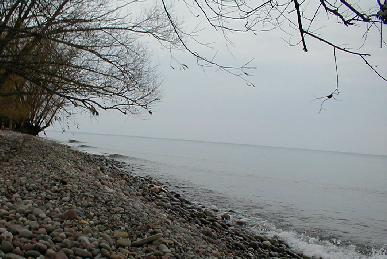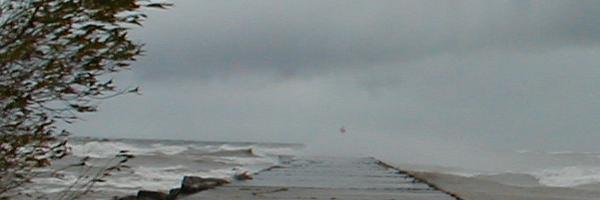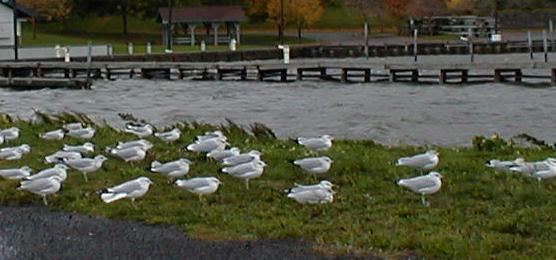Log
on Line November 2001

Fall, when the lake levels are
nearing their annual low and beaches are wide and quiet, is an especially favorable
time for walking along the water's edge. It's also a good time to reflect back
on the year that was- a strange somber year at its end. A year bright with
promise at its start but darkened with uncertainty in November.
The
graceful swift swooping swallows and the song birds of summer are gone now but
by November you usually begin to see sizeable flocks of diving ducks offshore.
The mergansers, buffleheads and scaup are common now even as most of the
cormorants moved on south sometime during October. A bit earlier in the fall I
occasionally heard the loons calling during my excursions on beach and by boat.
But I think they too are now in lower latitudes. Herons are still around. I saw one today (Nov 2) perched on a
rock just awash off shore in the open lake. It was a calm gray day and he must
have though some open lake fishing was worth while. We still have the hardy
gulls soaring on the wind and last week I saw a big brown bird fly out of a
snag up along Cayuga County's shoreline that I'm pretty confident was one of
those juvenile eagles again.
Fall
can bring quiet mild gray pensive days. Or it can bring strong winds. Around
the middle of October a strong low pressure with gale force winds out of the
southwest, shifting to west came sweeping in. By 2 pm 8 to 10 foot waves were
crashing over the Oswego harbor jetty sending spray as high as the lighthouse
roof. Waves in excess of 11 feet were registering on "superbouy" off
Point Traverse and Galloo was reading gusts to 50 knots with a steady 39 knots.

Jetty
at Fair Haven during October storm
We
drove up to see for ourselves at Oswego and at Fair Haven. At the entrance
channel to Fair Haven five foot swells were rolling down the channel between
the breakwaters. Sand flew before the wind like driven snow flying offshore
into the water. The strong wind made it hard to stand at times as it buffeted
us around.
A
few days later at the Nature Center's eastern edge the cobble beach showed a
dramatic steep angled storm berm formed by the big waves. I stood atop this
bank of large bread loaf sized cobbles cast up and shaped by waves and was
easily ten feet above the then calm water.
Fall
and winter gales are great fun to watch when you are safely ashore. But picture
those late 19th century schoonermen out there with leaking wooden
hulls spitting their oakum, patched half rotten canvas sails, and pumps going
full tilt. It's a wonder they ever survived. But of course many did. Most
insurers would not issue policies after October's end though. Not hard to see the
logic of that.

Gulls hunkered down for a blow in Oswego
during the October gale
Here's
a snippet of a recall from C.H.J. Snider's Schooner days in which an old
mariner recalls the storm of 1880, a fall gale that struck Nov 5.
"Well sir, worst I ever saw was that night all them vessels was lost, the year I was married. All the old hands along the front know about that. On Lake Erie that night the water raised twelve feet at Buffalo, piled up by the push of the wind. up at the other end of the lake it was lowered eight feet. I've heard tell how the "Clara Youell" was loading grain at Toledo. In the morning the mate got up and thought the grain shovelers must have been trimming her by the head through the night and putting a bad list in her, for the cabin doors wouldn't swing. He looked over the side and saw she washard and fast on the bottom of the river; although he had sounded and got
twenty feet alongside when the trimmers
knocked off the night before….
Our boats are tucked away for the winter
now. The lists of things to fix and or replace are being drawn up and we're
starting to spend lots more time indoors sailing on the world wide web and
maybe doing a bit of writing too. Well, there's always a bright side to
winter. Maybe the coming cold weather
will send all the lady bugs now plaguing the Log's office into dormancy!